Automatic Extension of a Semi-Detailed Synthetic Fuel Reaction Mechanism
Abstract
1. Introduction
2. Materials and Methods
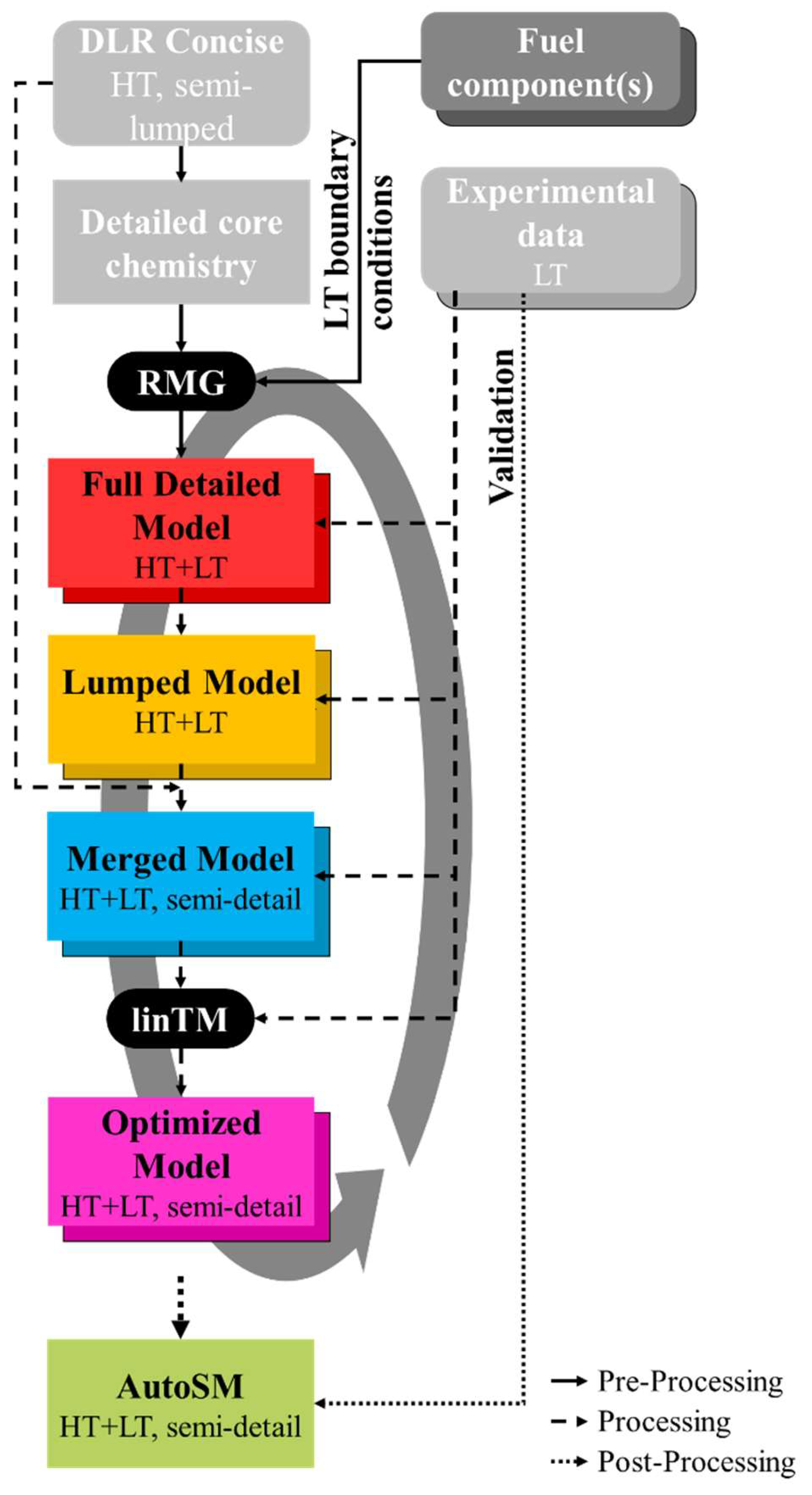
2.1. Pre-Processing
2.2. Processing
2.3. Post-Processing
3. Results and Discussion
3.1. n-Heptane
3.2. Isooctane
3.3. Overall Model Validation
4. Conclusions
Supplementary Materials
Author Contributions
Funding
Data Availability Statement
Conflicts of Interest
References
- Wang, M.; Dewil, R.; Maniatis, K.; Wheeldon, J.; Tan, T.; Baeyens, J.; Fang, Y. Biomass-derived aviation fuels: Challenges and perspective. Prog. Energy Combust. Sci. 2019, 74, 31–49. [Google Scholar] [CrossRef]
- Drünert, S.; Neuling, U.; Zitscher, T.; Kaltschmitt, M. Power-to-Liquid fuels for aviation—Processes, resources and supply potential under German conditions. Appl. Energy 2020, 277, 115578. [Google Scholar] [CrossRef]
- Kohse-Höinghaus, K. Combustion in the future: The importance of chemistry. Proc. Combust. Inst. 2020, 38, 1–56. [Google Scholar] [CrossRef] [PubMed]
- Heyne, J.; Rauch, B.; Le Clercq, P.; Colket, M. Sustainable aviation fuel prescreening tools and procedures. Fuel 2021, 290, 120004. [Google Scholar] [CrossRef]
- D02 Committee. Practice for Evaluation of New Aviation Turbine Fuels and Fuel Additives; ASTM International: West Conshohocken, PA, USA, 2021. [Google Scholar]
- D02 Committee. Specification for Diesel Fuel; ASTM International: West Conshohocken, PA, USA, 2022. [Google Scholar]
- Rumizen, M.A. Qualification of Alternative Jet Fuels. Front. Energy Res. 2021, 9, 760713. [Google Scholar] [CrossRef]
- Schmidt, M.; Schlichting, S.; Melder, J.; Methling, T.; Köhler, M.; Huber, A. Determination of Cetane Numbers via Chemical Kinetic Mechanism. J. Eng. Gas Turbines Power 2024, 146, 021018. [Google Scholar] [CrossRef]
- Abdul Jameel, A.G.; van Oudenhoven, V.C.; Naser, N.; Emwas, A.-H.; Gao, X.; Sarathy, S.M. Predicting Ignition Quality of Oxygenated Fuels Using Artificial Neural Networks. SAE Int. J. Fuels Lubr. 2021, 14, 57–86. [Google Scholar] [CrossRef]
- Peiffer, E.E.; Heyne, J.S.; Colket, M. Sustainable Aviation Fuels Approval Streamlining: Auxiliary Power Unit Lean Blowout Testing. AIAA J. 2019, 57, 4854–4862. [Google Scholar] [CrossRef]
- Won, S.H.; Rock, N.; Lim, S.J.; Nates, S.; Carpenter, D.; Emerson, B.; Lieuwen, T.; Edwards, T.; Dryer, F.L. Preferential vaporization impacts on lean blow-out of liquid fueled combustors. Combust. Flame 2019, 205, 295–304. [Google Scholar] [CrossRef]
- Badra, J.A.; Bokhumseen, N.; Mulla, N.; Sarathy, S.M.; Farooq, A.; Kalghatgi, G.; Gaillard, P. A methodology to relate octane numbers of binary and ternary n-heptane, iso-octane and toluene mixtures with simulated ignition delay times. Fuel 2015, 160, 458–469. [Google Scholar] [CrossRef]
- Fioroni, G.M.; Rahimi, M.J.; Westbrook, C.K.; Wagnon, S.W.; Pitz, W.J.; Kim, S.; McCormick, R.L. Chemical kinetic basis of synergistic blending for research octane number. Fuel 2022, 307, 121865. [Google Scholar] [CrossRef]
- Westbrook, C.K.; Sjöberg, M.; Cernansky, N.P. A new chemical kinetic method of determining RON and MON values for single component and multicomponent mixtures of engine fuels. Combust. Flame 2018, 195, 50–62. [Google Scholar] [CrossRef]
- Zhang, P.; Yee, N.W.; Filip, S.V.; Hetrick, C.E.; Yang, B.; Green, W.H. Modeling study of the anti-knock tendency of substituted phenols as additives: An application of the reaction mechanism generator (RMG). Phys. Chem. Chem. Phys. 2018, 20, 10637–10649. [Google Scholar] [CrossRef]
- Schlichting, S.; Methling, T.; Oßwald, P.; Zinsmeister, J.; Riedel, U.; Köhler, M. Numerical prediction of research octane numbers via a quasi-dimensional two-zone cylinder model. Appl. Energy Combust. Sci. 2022, 11, 100079. [Google Scholar] [CrossRef]
- Melder, J.; Zinsmeister, J.; Grein, T.; Jürgens, S.; Köhler, M.; Oßwald, P. Comprehensive Two-Dimensional Gas Chromatography: A Universal Method for Composition-Based Prediction of Emission Characteristics of Complex Fuels. Energy Fuels 2023, 37, 4580–4595. [Google Scholar] [CrossRef]
- Johnson, M.S.; Dong, X.; Grinberg Dana, A.; Chung, Y.; Farina, D.; Gillis, R.J.; Liu, M.; Yee, N.W.; Blondal, K.; Mazeau, E.; et al. RMG Database for Chemical Property Prediction. J. Chem. Inf. Model. 2022, 62, 4906–4915. [Google Scholar] [CrossRef] [PubMed]
- Liu, M.; Grinberg Dana, A.; Johnson, M.S.; Goldman, M.J.; Jocher, A.; Payne, A.M.; Grambow, C.A.; Han, K.; Yee, N.W.; Mazeau, E.J.; et al. Reaction Mechanism Generator v3.0: Advances in Automatic Mechanism Generation. J. Chem. Inf. Model. 2021, 61, 2686–2696. [Google Scholar] [CrossRef] [PubMed]
- Elliott, S.N.; Moore, K.B.; Copan, A.V.; Keçeli, M.; Cavallotti, C.; Georgievskii, Y.; Schaefer, H.F.; Klippenstein, S.J. Automated theoretical chemical kinetics: Predicting the kinetics for the initial stages of pyrolysis. Proc. Combust. Inst. 2021, 38, 375–384. [Google Scholar] [CrossRef]
- Döntgen, M.; Przybylski-Freund, M.-D.; Kröger, L.C.; Kopp, W.A.; Ismail, A.E.; Leonhard, K. Automated discovery of reaction pathways, rate constants, and transition states using reactive molecular dynamics simulations. J. Chem. Theory Comput. 2015, 11, 2517–2524. [Google Scholar] [CrossRef] [PubMed]
- Vandewiele, N.M.; van Geem, K.M.; Reyniers, M.-F.; Marin, G.B. Genesys: Kinetic model construction using chemo-informatics. Chem. Eng. J. 2012, 207–208, 526–538. [Google Scholar] [CrossRef]
- Cavallotti, C. Automation of chemical kinetics: Status and challenges. Proc. Combust. Inst. 2023, 39, 11–28. [Google Scholar] [CrossRef]
- Liu, M.; Chu, T.-C.; Jocher, A.; Smith, M.C.; Lengyel, I.; Green, W.H. Predicting polycyclic aromatic hydrocarbon formation with an automatically generated mechanism for acetylene pyrolysis. Int. J. Chem. Kinet. 2021, 53, 27–42. [Google Scholar] [CrossRef]
- Dana, A.G.; Buesser, B.; Merchant, S.S.; Green, W.H. Automated Reaction Mechanism Generation Including Nitrogen as a Heteroatom. Int. J. Chem. Kinet. 2018, 50, 243–258. [Google Scholar] [CrossRef]
- Nadiri, S.; Shu, B.; Goldsmith, C.F.; Fernandes, R. Development of comprehensive kinetic models of ammonia/methanol ignition using Reaction Mechanism Generator (RMG). Combust. Flame 2023, 251, 112710. [Google Scholar] [CrossRef]
- Kathrotia, T.; Oßwald, P.; Naumann, C.; Richter, S.; Köhler, M. Combustion kinetics of alternative jet fuels, Part-II: Reaction model for fuel surrogate. Fuel 2021, 302, 120736. [Google Scholar] [CrossRef]
- Warnatz, J.; Maas, U.; Dibble, R.W. Combustion: Physical and Chemical Fundamentals, Modeling and Simulation, Experiments, Pollutant Formation, 4th ed.; Springer: Berlin/Heidelberg, Germany, 2006; ISBN 3540259929. [Google Scholar]
- Curran, H.J. Developing detailed chemical kinetic mechanisms for fuel combustion. Proc. Combust. Inst. 2019, 37, 57–81. [Google Scholar] [CrossRef]
- Gao, C.W.; Liu, M.; Green, W.H. Uncertainty analysis of correlated parameters in automated reaction mechanism generation. Int. J. Chem. Kinet. 2020, 52, 266–282. [Google Scholar] [CrossRef]
- Cai, L.; Pitsch, H. Mechanism optimization based on reaction rate rules. Combust. Flame 2014, 161, 405–415. [Google Scholar] [CrossRef]
- Goodwin, D.G.; Moffat, H.K.; Schoegl, I.; Speth, R.L.; Weber, B.W. Cantera: An Object-Oriented Software Toolkit for Chemical Kinetics, Thermodynamics, and Transport Processes, Version 2.5.1; Cantera Developers: Warrenville, IL, USA, 2017. [Google Scholar]
- Methling, T.; Braun-Unkhoff, M.; Riedel, U. A novel linear transformation model for the analysis and optimisation of chemical kinetics. Combust. Theory Model. 2017, 21, 503–528. [Google Scholar] [CrossRef]
- Shao, J.; Choudhary, R.; Peng, Y.; Davidson, D.F.; Hanson, R.K. A shock tube study of n-heptane, iso-octane, n-dodecane and iso-octane/n-dodecane blends oxidation at elevated pressures and intermediate temperatures. Fuel 2019, 243, 541–553. [Google Scholar] [CrossRef]
- Johnson, M.S.; Pang, H.-W.; Liu, M.; Green, W.H. Species Selection for Automatic Chemical Kinetic Mechanism Generation. ChemRxiv 2024. preprint. [Google Scholar] [CrossRef]
- RMG-Py Github Repository, Issue Section, Issue Number 2521. Available online: https://github.com/ReactionMechanismGenerator/RMG-Py/issues/2521 (accessed on 18 December 2023).
- Methling, T.; Braun-Unkhoff, M.; Riedel, U. An optimised chemical kinetic model for the combustion of fuel mixtures of syngas and natural gas. Fuel 2020, 262, 116611. [Google Scholar] [CrossRef]
- Baulch, D.L.; Bowman, C.T.; Cobos, C.J.; Cox, R.A.; Just, T.; Kerr, J.A.; Pilling, M.J.; Stocker, D.; Troe, J.; Tsang, W.; et al. Evaluated Kinetic Data for Combustion Modeling: Supplement II. J. Phys. Chem. Ref. Data 2005, 34, 757–1397. [Google Scholar] [CrossRef]
- Ranzi, E.; Frassoldati, A.; Stagni, A.; Pelucchi, M.; Cuoci, A.; Faravelli, T. Reduced Kinetic Schemes of Complex Reaction Systems: Fossil and Biomass-Derived Transportation Fuels. Int. J. Chem. Kinet. 2014, 46, 512–542. [Google Scholar] [CrossRef]
- Mehl, M.; Pitz, W.J.; Westbrook, C.K.; Curran, H.J. Kinetic modeling of gasoline surrogate components and mixtures under engine conditions. Proc. Combust. Inst. 2011, 33, 193–200. [Google Scholar] [CrossRef]
- Fieweger, K.; Blumenthal, R.; Adomeit, G. Self-ignition of S.I. engine model fuels: A shock tube investigation at high pressure. Combust. Flame 1997, 109, 599–619. [Google Scholar] [CrossRef]
- AlAbbad, M.; Javed, T.; Khaled, F.; Badra, J.; Farooq, A. Ignition delay time measurements of primary reference fuel blends. Combust. Flame 2017, 178, 205–216. [Google Scholar] [CrossRef]
- Herbinet, O.; Husson, B.; Serinyel, Z.; Cord, M.; Warth, V.; Fournet, R.; Glaude, P.-A.; Sirjean, B.; Battin-Leclerc, F.; Wang, Z.; et al. Experimental and modeling investigation of the low-temperature oxidation of n-heptane. Combust. Flame 2012, 159, 3455–3471. [Google Scholar] [CrossRef] [PubMed]

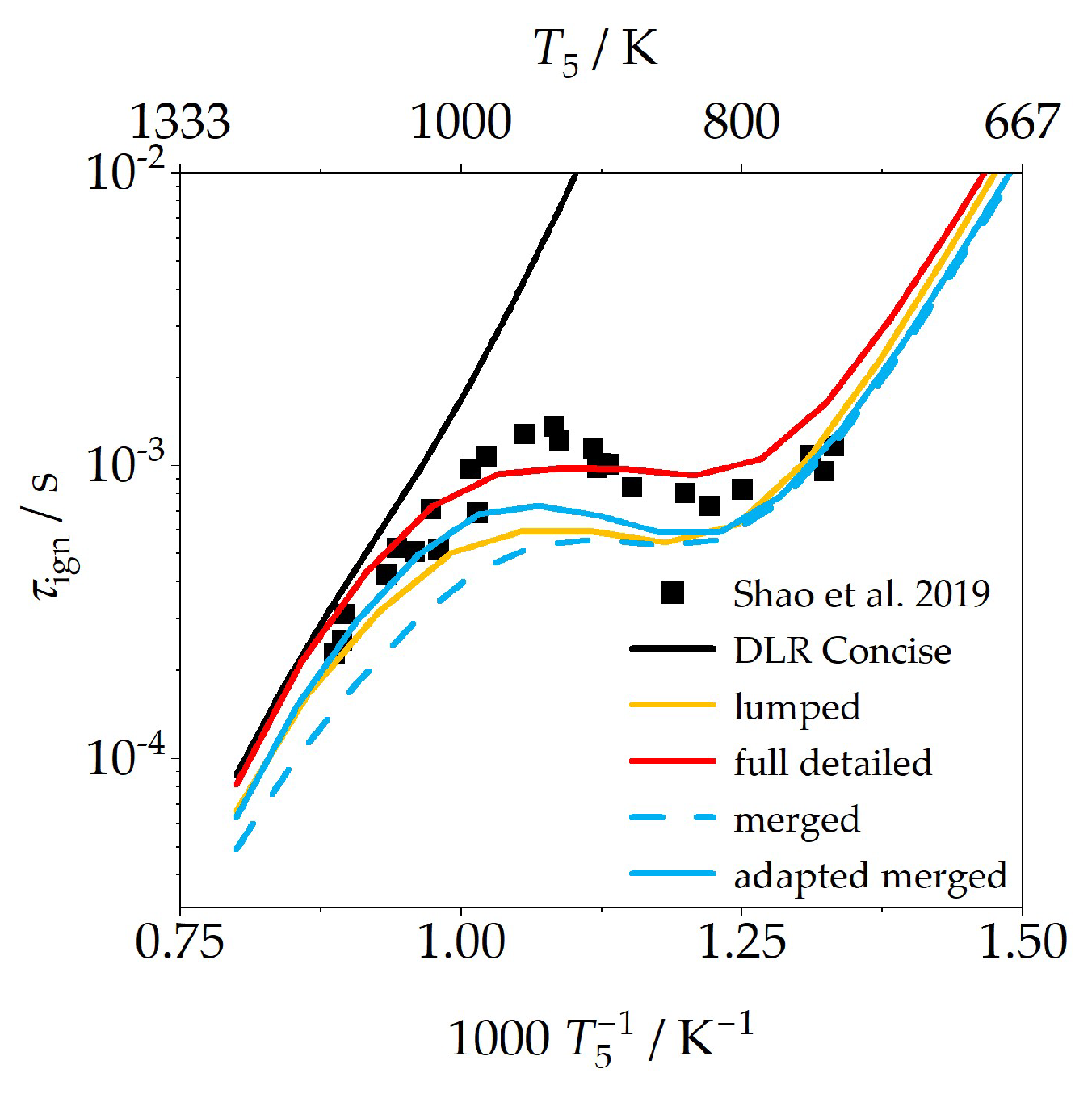
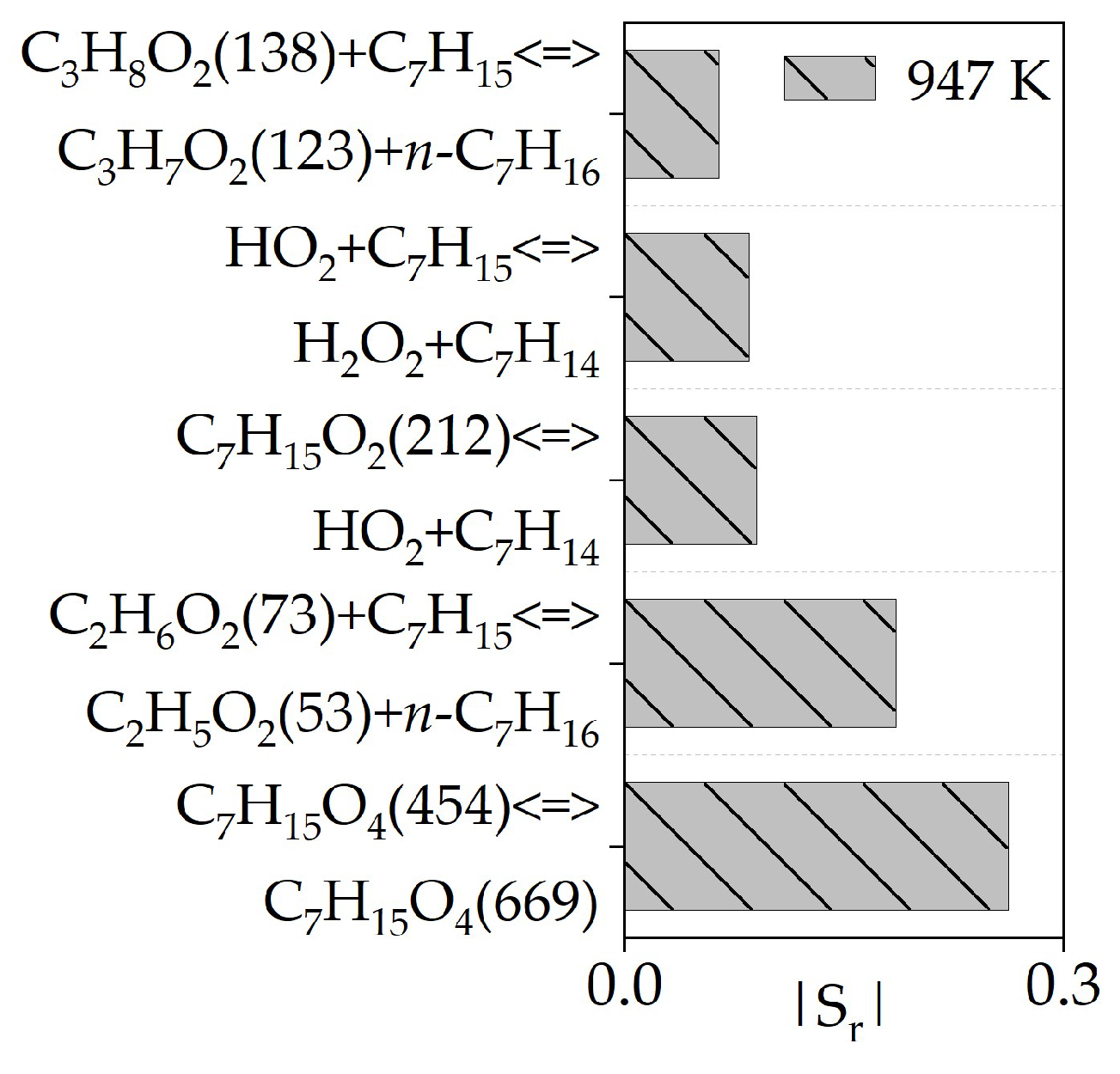
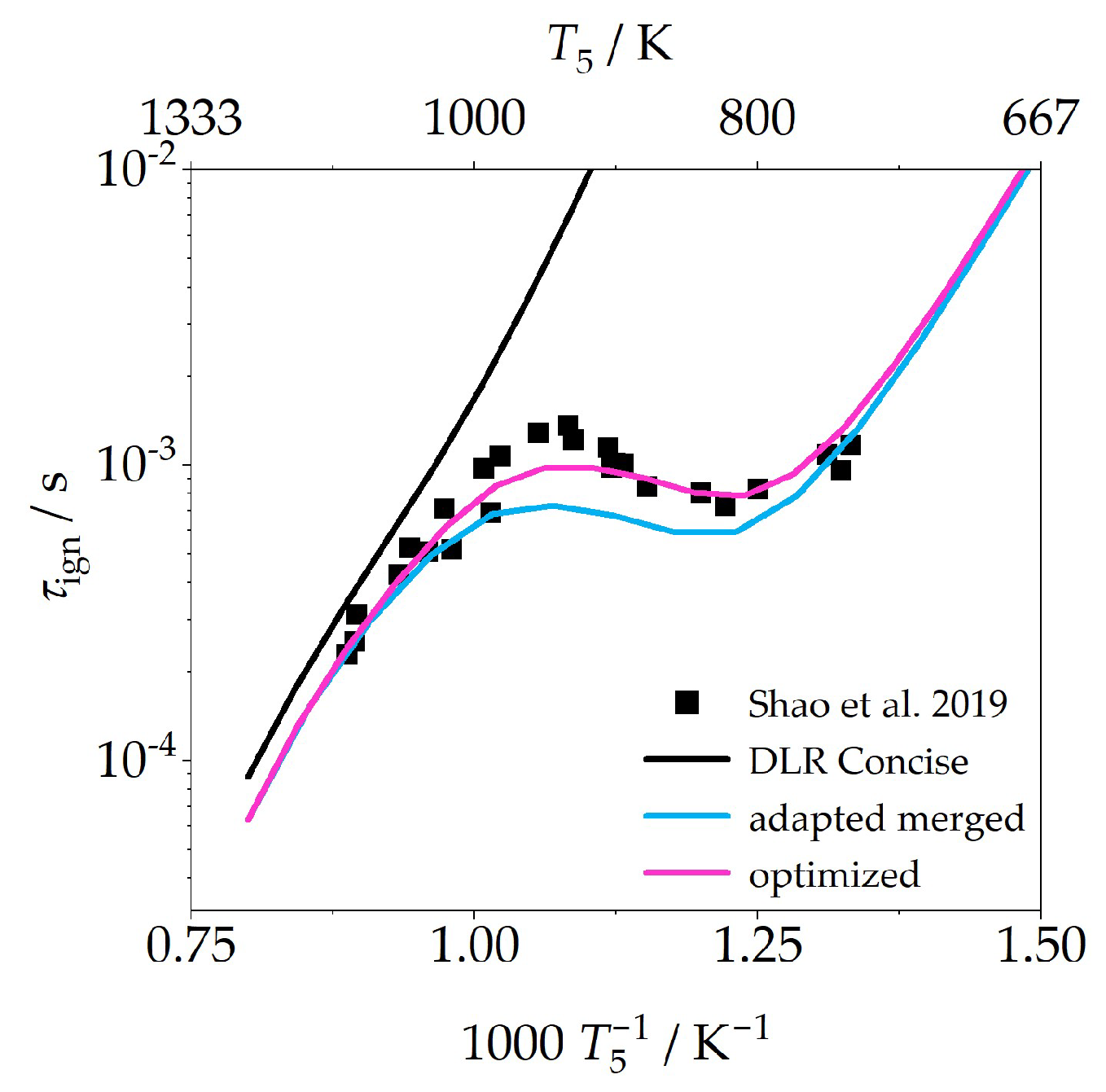
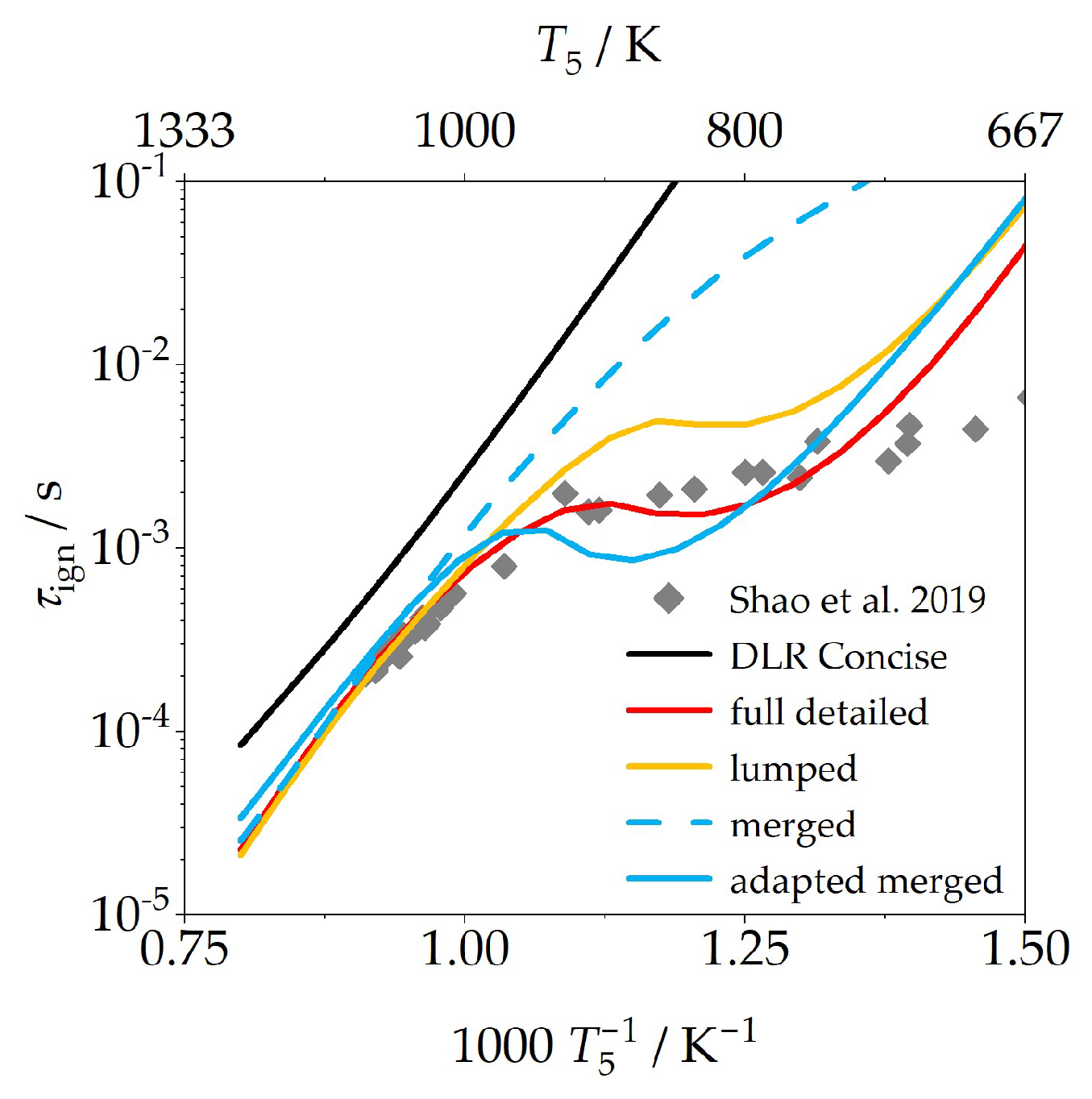
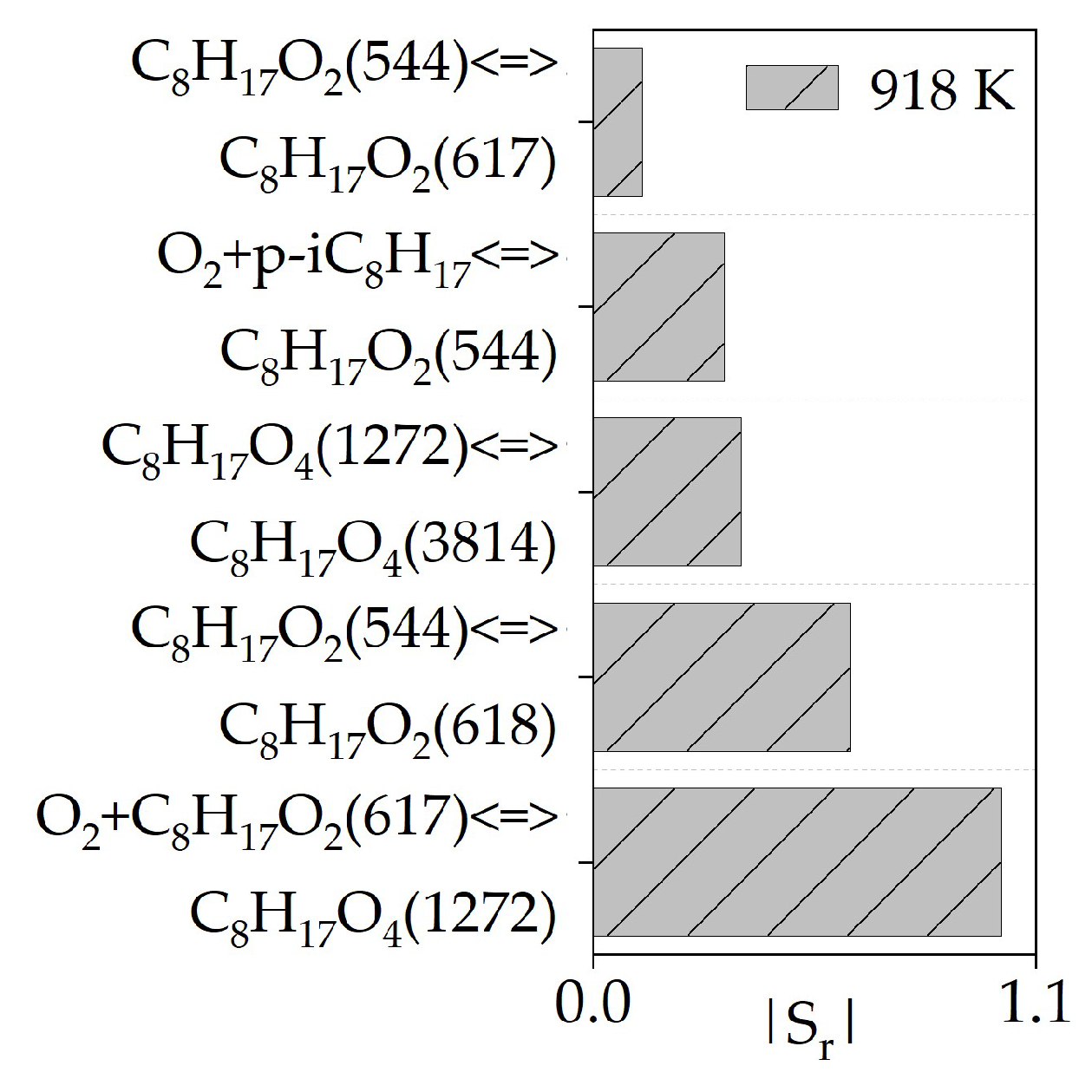
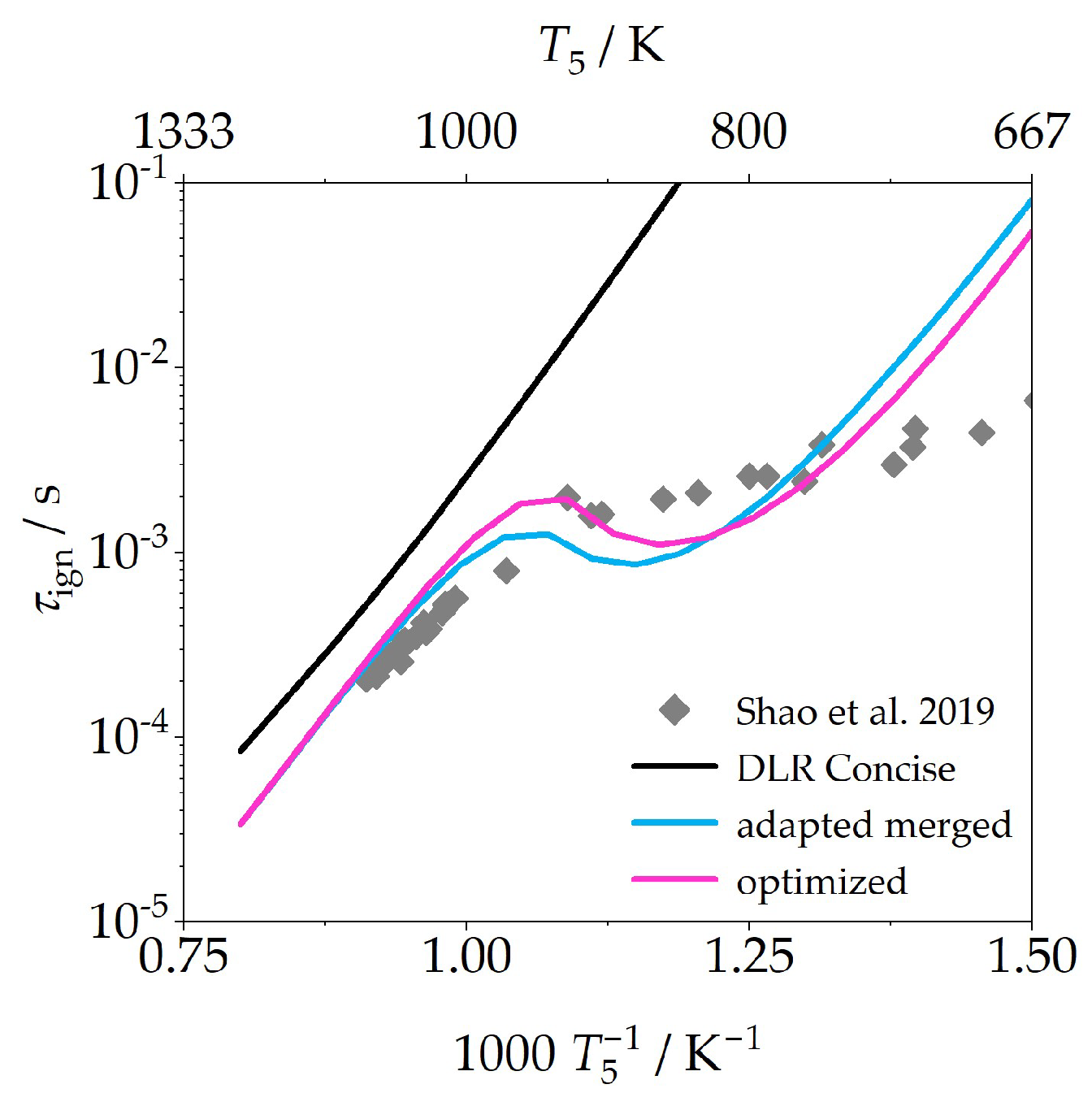
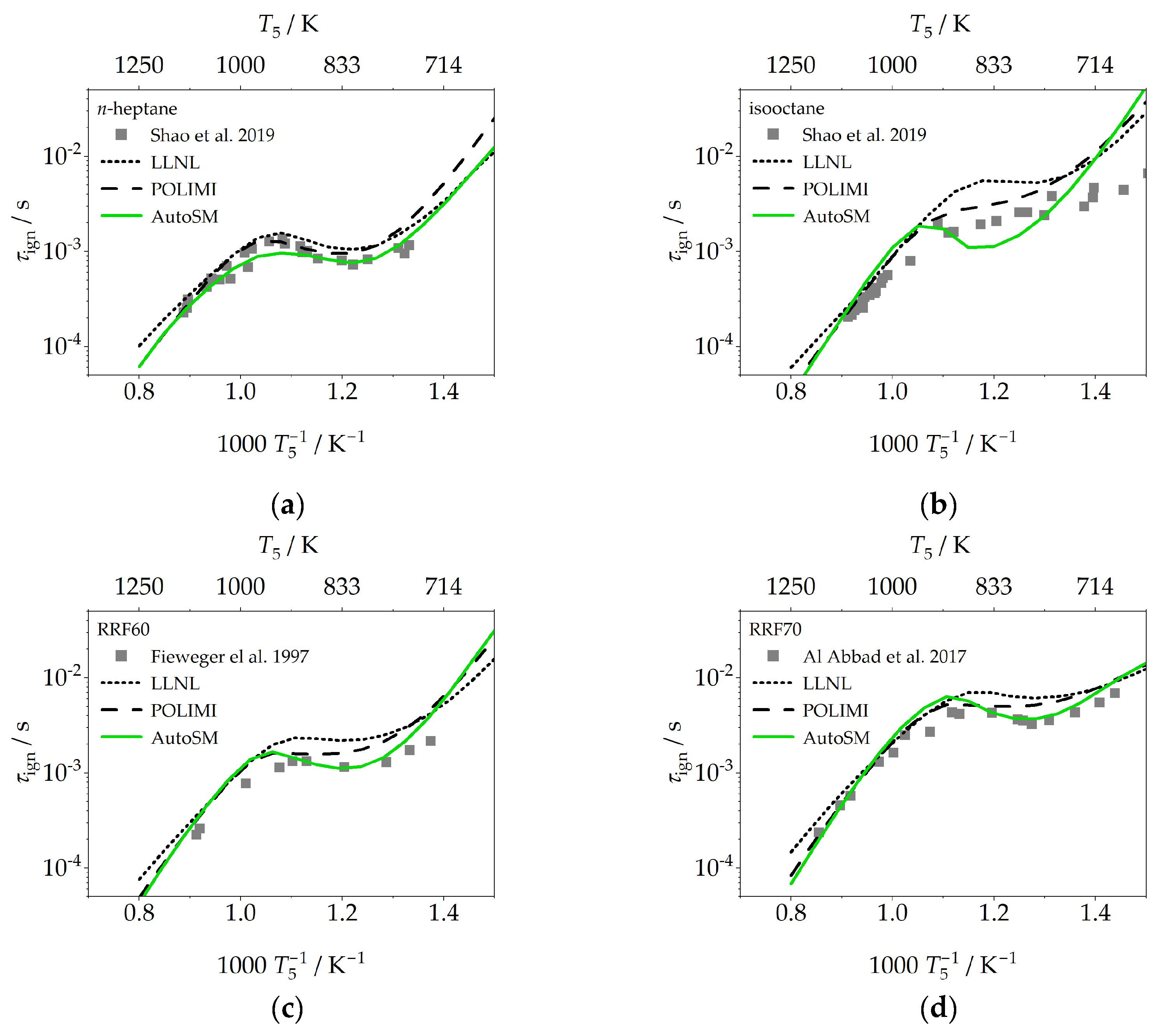
| n-Heptane | Isooctane | |
|---|---|---|
| thermoLibraries | ‘Detailed_core_chemistry’ | |
| ‘Klippenstein_Glarborg2016’ | ||
| ‘primaryThermoLibrary’ | ||
| reactionLibraries | ‘Detailed_core_chemistry’ | |
| ‘Klippenstein_Glarborg2016’ | ||
| ‘Glarborg/C3’ | ||
| Temperature in K | 650–1200 | 600–1200 |
| Pressure in bar | 1–20 | 20–55 |
| Equivalence ratio | 1 | |
| nSims | 12 | |
| terminationConversion | 0.9 | |
| terminationTime in s | 20 | |
| toleranceKeepInEdge | 0.01 | |
| toleranceMoveToCore | 0.1 | |
| toleranceBranchReactionToCore | 0.001 | - |
| branchingIndex | 0.5 | - |
| branchingRatioMax | 1 | - |
| toleranceInterruptSimulation | ||
| maximumEdgeSpecies | ||
| filterReactions | True | |
| Mechanism | n-Heptane | Isooctane | PRF60 | PRF70 |
|---|---|---|---|---|
| POLIMI | 5.09 | 12.63 | 3.94 | 4.40 |
| LLNL | 7.01 | 16.33 | 5.56 | 6.43 |
| AutoSM | 3.50 | 14.38 | 1.65 | 2.44 |
Disclaimer/Publisher’s Note: The statements, opinions and data contained in all publications are solely those of the individual author(s) and contributor(s) and not of MDPI and/or the editor(s). MDPI and/or the editor(s) disclaim responsibility for any injury to people or property resulting from any ideas, methods, instructions or products referred to in the content. |
© 2024 by the authors. Licensee MDPI, Basel, Switzerland. This article is an open access article distributed under the terms and conditions of the Creative Commons Attribution (CC BY) license (https://creativecommons.org/licenses/by/4.0/).
Share and Cite
Schmidt, M.; Eberl, C.A.K.; Jacobs, S.; Methling, T.; Huber, A.; Köhler, M. Automatic Extension of a Semi-Detailed Synthetic Fuel Reaction Mechanism. Energies 2024, 17, 999. https://doi.org/10.3390/en17050999
Schmidt M, Eberl CAK, Jacobs S, Methling T, Huber A, Köhler M. Automatic Extension of a Semi-Detailed Synthetic Fuel Reaction Mechanism. Energies. 2024; 17(5):999. https://doi.org/10.3390/en17050999
Chicago/Turabian StyleSchmidt, Marleen, Celina Anne Kathrin Eberl, Sascha Jacobs, Torsten Methling, Andreas Huber, and Markus Köhler. 2024. "Automatic Extension of a Semi-Detailed Synthetic Fuel Reaction Mechanism" Energies 17, no. 5: 999. https://doi.org/10.3390/en17050999
APA StyleSchmidt, M., Eberl, C. A. K., Jacobs, S., Methling, T., Huber, A., & Köhler, M. (2024). Automatic Extension of a Semi-Detailed Synthetic Fuel Reaction Mechanism. Energies, 17(5), 999. https://doi.org/10.3390/en17050999






